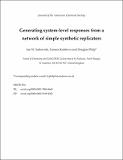Files in this item
Generating system-level responses from a network of simple synthetic replicators
Item metadata
| dc.contributor.author | Sadownik, Jan W. | |
| dc.contributor.author | Kosikova, Tamara | |
| dc.contributor.author | Philp, Douglas | |
| dc.date.accessioned | 2018-10-31T00:48:39Z | |
| dc.date.available | 2018-10-31T00:48:39Z | |
| dc.date.issued | 2017-12-06 | |
| dc.identifier | 251504401 | |
| dc.identifier | e0f34f1b-a3f9-4593-81cb-0afa0af7c187 | |
| dc.identifier | 85037535430 | |
| dc.identifier | 000417669000053 | |
| dc.identifier.citation | Sadownik , J W , Kosikova , T & Philp , D 2017 , ' Generating system-level responses from a network of simple synthetic replicators ' , Journal of the American Chemical Society , vol. 139 , no. 48 , pp. 17565-17573 . https://doi.org/10.1021/jacs.7b09735 | en |
| dc.identifier.issn | 0002-7863 | |
| dc.identifier.other | ORCID: /0000-0002-9198-4302/work/56639232 | |
| dc.identifier.uri | https://hdl.handle.net/10023/16358 | |
| dc.description | The financial support for this work was provided by EaStCHEM and the Engineering and Physical Sciences Research Council (Grant EP/K503162/1). | en |
| dc.description.abstract | The creation of reaction networks capable of exhibiting responses that are properties of entire systems represents a significant challenge for the chemical sciences. The system- level behavior of a reaction network is linked intrinsically to its topology and the functional connections between its nodes. A simple network of chemical reactions constructed from four reagents, in which each reagent reacts with exactly two others, can exhibit up-regulation of two products even when only a single chemical reaction is addressed catalytically. We implement a system with this topology using two maleimides and two nitrones of different sizes—either short or long and each bearing complementary recognition sites—that react pairwise through 1,3-dipolar cycloaddition reactions to create a network of four length-segregated replicating templates. Comprehensive 1H NMR spectroscopy experiments unravel the network topology, confirming that, in isolation, three out of four templates self-replicate, with the shortest template exhibiting the highest efficiency. The strongest template effects within the network are the mutually cross-catalytic relationships between the two templates of intermediate size. The network topology is such that the addition of different preformed templates as instructions to a mixture of all starting materials elicits system-level behavior. Instruction with a single template up-regulates the formation of two templates in a predictable manner. These results demonstrate that the rules governing system-level behavior can be unraveled through the application of wholly synthetic networks with well-defined chemistries and interactions. | |
| dc.format.extent | 1681161 | |
| dc.language.iso | eng | |
| dc.relation.ispartof | Journal of the American Chemical Society | en |
| dc.subject | QD Chemistry | en |
| dc.subject | DAS | en |
| dc.subject | BDC | en |
| dc.subject | R2C | en |
| dc.subject.lcc | QD | en |
| dc.title | Generating system-level responses from a network of simple synthetic replicators | en |
| dc.type | Journal article | en |
| dc.contributor.institution | University of St Andrews. School of Chemistry | en |
| dc.contributor.institution | University of St Andrews. EaSTCHEM | en |
| dc.contributor.institution | University of St Andrews. Biomedical Sciences Research Complex | en |
| dc.identifier.doi | 10.1021/jacs.7b09735 | |
| dc.description.status | Peer reviewed | en |
| dc.date.embargoedUntil | 2018-10-31 |
This item appears in the following Collection(s)
Items in the St Andrews Research Repository are protected by copyright, with all rights reserved, unless otherwise indicated.

